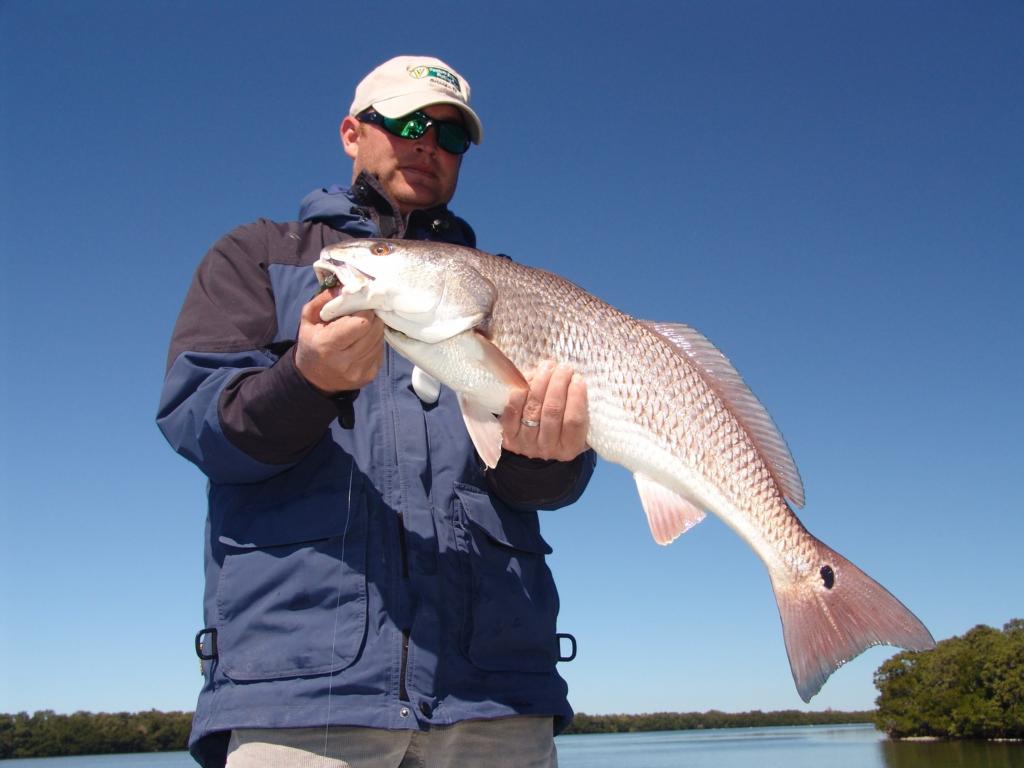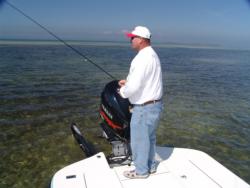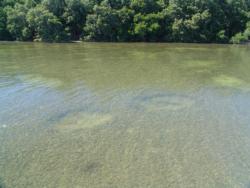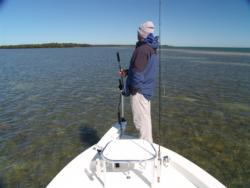Go ahead and stop
Boat control, right equipment critical to redfish fishing success

One of the most important traits of a successful redfish angler is knowing when to stop. That doesn’t mean stop fishing; it means stop forward motion, then resume. Then stop again, and resume. And then … well, you get the picture.
Predicated on the art of incremental advancement, this stop-and-go pattern allows you to fish more precisely and optimize your opportunities. Kind of like a football team playing ball-control offense, this is a game of measured movements, rather than random shots at the big play.
Competitors in the Wal-Mart FLW Redfish Series catch plenty of reds while drifting and blind-casting over pothole-strewn grass beds, but that scenario isn’t always most prudent. Sometimes you just need to target a specific oyster bar, trough or mangrove shoreline.
Elsewhere, a hookup or the sudden appearance of fish may require a quick stop. Even at moderate drift speed, you can overtake a pod of fish and spook them in a matter of seconds. Moreover, because hooked reds usually try to stay with their school for security, a big fish may actually pull a drifting boat close enough to spook the other fish.
Tools and tactics
In the simplest mechanism, a push pole can serve as accelerator and brake. Angle the pole forward to halt the boat, and then stake out by planting the tip of the pole into the bottom and roping the foot end to the poling platform. Effective, but this tactic takes a little time to completely execute.
We’re only talking about maybe 30 to 60 seconds for an experienced angler. But this is seemingly the age of instant gratification, and a lot of redfish can slip out of range in under a minute. You can play the cat-and-mouse game if you’d like, or you can stop where you want, when you want, and make the cast you need to make.
 Tournament pros typically accomplish this with the Power-Pole Shallow Water Anchor – unquestionably, one of the most revolutionary piece of boating equipment to come along in decades. Mounting to a boat’s transom just above the water line, a hydraulic arm extends a durable composite spike and sinks it into the bottom. Controlled by wired switches or remote devices (worn on clip chains), the Power-Pole operates quickly, quietly and with minimal environmental impact.
Tournament pros typically accomplish this with the Power-Pole Shallow Water Anchor – unquestionably, one of the most revolutionary piece of boating equipment to come along in decades. Mounting to a boat’s transom just above the water line, a hydraulic arm extends a durable composite spike and sinks it into the bottom. Controlled by wired switches or remote devices (worn on clip chains), the Power-Pole operates quickly, quietly and with minimal environmental impact.
Power-Pole inventor John Oliverio of Brandon, Fla. competes in the FLW Redfish Series, but his inspiration arose while battling a hard wind that kept pushing him over a spot inhabited by a herd of snook. Today, his creation gives anglers unparalleled control over their shallow-water movement.
“It’s like having brakes on your boat,” Oliverio said. “If wind is blowing you along and you’re around fish, the first thing you want to do is stop. (Similar to) hunting, if you were being blown through the woods, you’d never shoot a deer.”
Capt. Greg DeVault of New Port Richey, Fla., has Power-Poles installed on his Ranger Ghost skiff and on his 22-foot Ranger bay boat. For hunting and fighting redfish, he considers the ability to instantly control his vessel’s position invaluable.
“A Power-Pole is as important as having polarized sunglasses – there are days when I’d rather fish without my sunglasses than without my Power-Pole,” DeVault said. “It’s probably second only to your rods and reels.
“Where it’s really handy is when you hook a fish. As soon as one person hooks a fish, the first thing the other angler does is drop the Power-Pole.”
 DeVault said that quickly stopping the boat proves strategic when fighting redfish around docks or oyster bars.
DeVault said that quickly stopping the boat proves strategic when fighting redfish around docks or oyster bars.
“It gives you a solid base to turn a fish from the structure. It allows you to handle a fish without the boat intruding on the area you’re fishing.”
Spooky fish are a constant concern for shallow-water fishermen, and the Power-Pole helps keep anglers in stealth mode.
“If you’re using the wind, you can work (a spot) without ever leaving the front of the boat or taking your hands off the rod and reel,” DeVault said. “You never have to use the trolling motor, so you’re completely silent.”
Poor man’s stop-and-go options
Granted, you don’t have to use a Power-Pole to fish the stop-and-go pattern. Slipping a small mushroom “sand” anchor off the stern will halt your boat in much the same fashion. Another option, a “Cajun Lance” comprises a stainless steel rod, wooden dowel or PVC pipe fitted with a rope. When thrust into the bottom, the stake holds the boat in place.
Both will get the job done for those fishing on limited budgets, but consider the sacrifice:
Immediacy: Even with a short rope, it takes at least a couple of seconds for the boat to stop.
Silence: Despite your steady hand, anchors have a high propensity for accidental bumping, dropping and other fish-spooking goofs.
Access: Until someone invents a remote-operated device for deploying a sand anchor or Cajun Lance, the Power-Pole remains superior.
Advantage … Power-Pole
By comparison, a Power-Pole stops a boat as soon as the shaft sinks into the bottom; the device emits nearly no sound; and remote-control switches enable you to raise or lower the spike from practically anywhere on the boat.
Rick Worman and Alon Beja, both of Rockledge, Fla., used the stop-and-go strategy to perfection March 22-24 as they won the Redfish Series Eastern Division event in Titusville, Fla. Targeting a 3-foot trench adjacent to a shallow flat in the Indian River Lagoon, they worked their way along a course where they had observed predictable redfish movement during practice fishing.
Propelling their flats skiff with a push pole, they gave their Power-Pole a good workout as they probed the hot zone. Low water clarity prohibited sight-fishing, but the motion of the boat, plus the sound of splashing lures, frequently stirred low-lying reds into disclosing their positions with wakes and swirls. The ability to instantly stop and work an area proved invaluable to their success.
“We would fish a spot, move down a little, fish another spot, and continue doing this until we found the fish we needed,” Beja said. “Sometimes, the fish would move enough for us to see (their location), and we’d cast to them.”
Stealth tip
 When using a push pole, consider that while this lanky tool serves your propulsion needs, it can also wreck your stealth effort. Most shallow-water anglers know better than to drop a pole on the deck, but accidental noise is no less harmful than reckless clumsiness.
When using a push pole, consider that while this lanky tool serves your propulsion needs, it can also wreck your stealth effort. Most shallow-water anglers know better than to drop a pole on the deck, but accidental noise is no less harmful than reckless clumsiness.
Avoid mishaps by securing the push pole between uses. Gunwale-mounted pole holders work best, but in the absence of these accessories, simply rest your pole on a plush bath towel. This muffles any initial contact noise and minimizes the pole’s sliding potential.